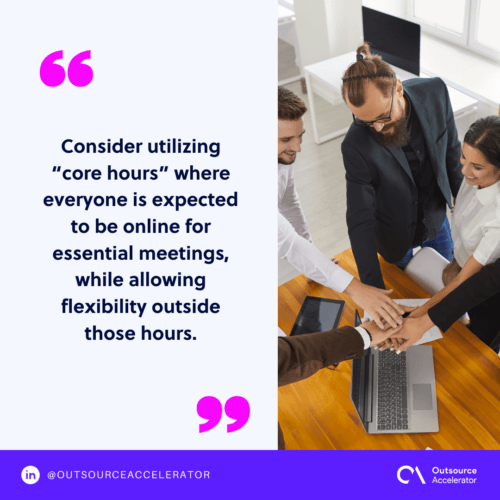Building effective remote teams: A roadmap to success

This article is a submission by Managed Services Partners. Managed Services Partners is an outsourcing agency with over six years of experience helping businesses improve operations and drive growth.
In the last 5 years remote work has become not just a trend but a necessity. As many businesses pivot to adopt this model, the need for building effective remote teams has never been more crucial.
There are quite a few intricacies involved in the outsourcing journey, and this article aims to share insights into how organizations can successfully build remote teams that foster productivity and collaboration.
Understanding the remote team landscape
The landscape of remote work is diverse and dynamic. With teams scattered across various geographical locations, the challenge lies in creating a cohesive unit that can collaborate effectively while navigating the complexities of distance.
For organizations venturing into the outsourcing journey, grasping this landscape is the first step toward creating an impactful remote team.
Adaptability: The key to success
One of the greatest assets in a remote team is adaptability. Each member brings their unique skills, experiences, and perspectives. It’s essential to embrace this diversity and foster an environment where team members can adapt to changes swiftly.
Companies must be prepared to adjust their strategies and workflows to accommodate various working styles and time zones.
To promote adaptability, businesses can employ the following strategies:
1. Foster a culture of trust
Trust is the backbone of any team, especially in a remote setting. Encourage team members to take the initiative and make decisions independently. When employees feel trusted, they are more likely to adapt to new challenges and collaborate effectively.

2. Encourage continuous learning
The remote work environment is constantly evolving.
Encourage team members to engage in professional development opportunities, such as online courses or workshops, which can equip them with new skills and knowledge that enhance their adaptability.
3. Solicit feedback regularly
Establishing a regular feedback loop is crucial. Team members should feel comfortable sharing their progress and any challenges they encounter.
This feedback allows managers to adapt processes or expectations as needed.
Establishing clear expectations
Building effective remote teams starts with establishing clear expectations. This ensures that every member understands their role, responsibilities, and the overall goals of the team.
Here are some steps to set crystal-clear expectations:
1. Define goals and objectives
Break down larger projects into specific, measurable, achievable, relevant, and time-bound (SMART) goals. Clearly map out what success looks like and communicate these objectives to the team.
2. Outline roles and responsibilities
Clearly define each team member’s role and what they are accountable for.
This not only minimizes confusion but also fosters ownership over tasks. Document these roles and share them with the team to ensure everyone is on the same page.
3. Utilize project management tools
Implement project management software such as Trello, Asana, or Monday.com. These tools help streamline workflows, assign tasks, and monitor progress, keeping team members aligned with objectives.
4. Implement regular check-ins
Set up regular weekly check-ins with each team member. These meetings should be a safe space for team members to discuss their ongoing projects, address any concerns, and seek guidance if needed.
This consistent communication strengthens relationships and allows for continuous alignment.
Building relationships in a remote world
Creating a strong sense of community within remote teams is essential for driving collaboration and engagement.
Here are some techniques for building relationships:
1. Leverage video conferencing tools
Video conferencing platforms like Zoom or Microsoft Teams can bridge the gap caused by geographical distances. Regular face-to-face interactions, even virtually, help team members connect on a personal level, making it easier to build trust and rapport.
2. Encourage social interaction
Many employees miss the spontaneous conversations that occur in an office environment. Allocate time during meetings for informal chats or virtual team-building activities.
These activities can range from trivia games to virtual coffee breaks, allowing team members to bond outside of work tasks.
3. Celebrate successes
Acknowledge individual and team accomplishments regularly. Whether it’s achieving a project milestone, completing a challenging task, or celebrating birthdays, recognizing efforts cultivates a positive team culture and fosters collaboration.
4. Promote inclusivity
Advocate for openness and respect within the team. Encourage diverse perspectives and ensure that every team member feels valued and included.
This approach enhances creativity and innovation as individuals feel empowered to share their ideas.
Tools for success
In addition to fostering culture and relationships, utilizing the right tools can significantly impact the effectiveness of remote teams.
Here are some essential tools to enhance collaboration:
1. Project management software: As mentioned earlier, tools like Asana, Trello, or ClickUp help keep track of tasks and deadlines. These platforms enhance accountability and allow for transparent progress tracking.
2. Communication platforms: Instant messaging applications like Slack or Microsoft Teams streamline communication, allowing for quick exchanges of ideas or urgent updates without the need for formal meetings.
3. Video conferencing: Zoom, Google Meet, and Microsoft Teams enable face-to-face discussions, boosting engagement and fostering deeper connections among team members.
4. File sharing and collaboration: Use cloud storage solutions like Google Drive, Dropbox, or Microsoft OneDrive for easy file sharing and collaboration on documents. These platforms facilitate real-time editing and ensure that everyone has access to the latest versions of their work, which is vital for maintaining productivity.
5. Time management tools: This not only helps with accountability but also allows individuals to understand how they allocate their time, leading to better time management and productivity.
Overcoming challenges in remote team management
Despite the many advantages of remote work, organizations may face several challenges along the way. Understanding these obstacles and having strategies to overcome them can further enhance the effectiveness of remote teams.
1. Time zone differences
When remote team members are distributed globally, coordinating work can become difficult. To address this, implement a shared calendar that reflects time zones for all team members.
Consider utilizing “core hours” where everyone is expected to be online for essential meetings, while allowing flexibility outside those hours.

2. Isolation and loneliness
Remote work can lead to feelings of loneliness or disconnection among team members. Combat this by encouraging virtual team-building exercises and maintaining an open-door policy for one-on-one check-ins.
Foster a culture where employees feel comfortable discussing their feelings and challenges.
3. Maintaining productivity
With distractions at home, some remote employees may struggle to stay productive. Monitor workloads and offer support to those who may need assistance in managing their tasks.
Encourage the use of time management techniques, such as the Pomodoro Technique, to help team members focus during work sessions.
Build remote teams with confidence
Building effective remote teams requires a clear structure that emphasizes adaptability, open communication, and strong relationships.
By establishing clear expectations from the outset, utilizing project management and communication tools, and fostering a culture of trust and inclusivity, organizations can thrive in the remote landscape.
The outsourcing journey does not have to be daunting. Instead, it can be an opportunity for growth and innovation.
As the world continues to embrace the possibilities of remote work, organizations that implement these strategies will not only overcome the inherent challenges but will also position themselves as leaders in the evolving landscape of work.
Let’s embark on this outsourcing journey together and build remote teams that are not only efficient but also vibrant and connected.







 Independent
Independent




